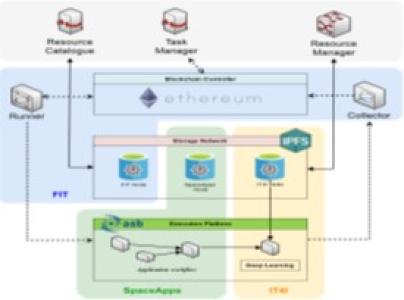Synergic use of Blockchain and Deep Learning for space data
Programme
TDE
Programme Reference
T708-601EF
Prime Contractor
SPACE APPLICATIONS SERV. S.A./N.V.
Start Date
End Date
Status
Closed
Country
Belgium

Objectives
Use blockchain technologies to facilitate the distribution and re-use of space data without compromising ownership and integrity. Assess blockchain algorithms and tools to train high performing artificial intelligence models over multiple sources of data
Description
Integrity and ownership of space data and of related algorithms and auxiliary datasets are two issues that contribute to slowing down the development of space data based science and applications, for example by restricting the application of deep learning approaches. Cloud systems are used mainly for accelerating complex calculations. However, developers create applications only on data they own because they do not trust any sharing and storage mechanism, often not covered by clear policies. As result, applications are based on algorithms trained with limited datasets and therefore they become quickly obsolete and they lose commercial/social value. A possible solution comes from Blockchain technologies, which are disrupting the cloud computing industry: any digital asset (currencies, data, applications, identities and processing power) can be securely tracked, used, commercialized and exchanged without any risk of theft and hack.
This activity investigates blockchain to train Artificial Intelligence (AI) models from decentralized sources of data while preserving ownership. The activity encompasses the following tasks:
- Identify a pilot case and related space data, e.g. Earth Observation products
- Assess available blockchain solutions and select one. Adapt its development tools and interfaces if required
- Make data compatible with blockchain architecture
- Develop Deep Learning models to process payload data
- Adapt these DL models to the blockchain interfaces, tools and execution mechanisms.
- Smart contract technologies to train DL models (mentioned before) without compromising ownership or disclosing data
- Assess blockchain consensus methods to converge efficiently and concurrently to optimized DL architectures
Benefits and applications
- Data and algorithms are securely shared. DL models become more accurate because trained with larger datasets
- Applications benefit from better models, consequently data is better understood and gains economic value
- Open market of space data and AI models become real and more profitable, not just for few companies
- Ground segments may include decentralized components for processing, cataloguing and distributing data with less integrity issues
Application Domain
Generic Technologies
Technology Domain
8 - System Design & Verification
9 - Mission Operation and Ground Data Systems
Competence Domain
9-Digital Engineering
Initial TRL
TRL 2
Target TRL
TRL 3
Public Document
